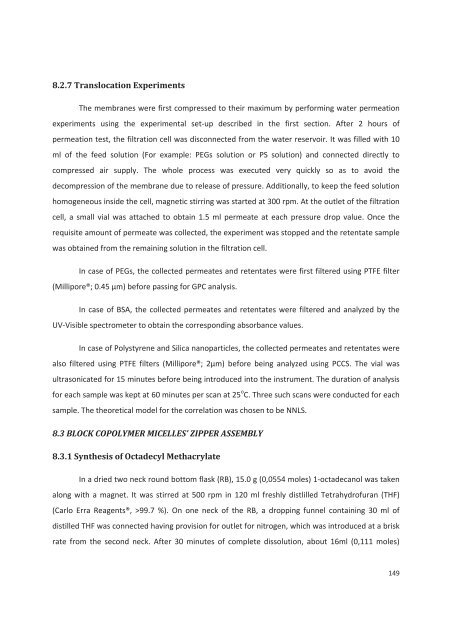4(%3)3 - Ecole nationale supérieure de chimie de Montpellier
4(%3)3 - Ecole nationale supérieure de chimie de Montpellier
4(%3)3 - Ecole nationale supérieure de chimie de Montpellier
You also want an ePaper? Increase the reach of your titles
YUMPU automatically turns print PDFs into web optimized ePapers that Google loves.
8.2.7 Translocation ExperimentsThe membranes were first compressed to their maximum by performing water permeationexperiments using the experimental set-up <strong>de</strong>scribed in the first section. After 2 hours ofpermeation test, the filtration cell was disconnected from the water reservoir. It was filled with 10ml of the feed solution (For example: PEGs solution or PS solution) and connected directly tocompressed air supply. The whole process was executed very quickly so as to avoid the<strong>de</strong>compression of the membrane due to release of pressure. Additionally, to keep the feed solutionhomogeneous insi<strong>de</strong> the cell, magnetic stirring was started at 300 rpm. At the outlet of the filtrationcell, a small vial was attached to obtain 1.5 ml permeate at each pressure drop value. Once therequisite amount of permeate was collected, the experiment was stopped and the retentate samplewas obtained from the remaining solution in the filtration cell.In case of PEGs, the collected permeates and retentates were first filtered using PTFE filter(Millipore®; 0.45 µm) before passing for GPC analysis.In case of BSA, the collected permeates and retentates were filtered and analyzed by theUV-Visible spectrometer to obtain the corresponding absorbance values.In case of Polystyrene and Silica nanoparticles, the collected permeates and retentates werealso filtered using PTFE filters (Millipore®; 2µm) before being analyzed using PCCS. The vial wasultrasonicated for 15 minutes before being introduced into the instrument. The duration of analysisfor each sample was kept at 60 minutes per scan at 25 o C. Three such scans were conducted for eachsample. The theoretical mo<strong>de</strong>l for the correlation was chosen to be NNLS.8.3 BLOCK COPOLYMER MICELLES’ ZIPPER ASSEMBLY8.3.1 Synthesis of Octa<strong>de</strong>cyl MethacrylateIn a dried two neck round bottom flask (RB), 15.0 g (0,0554 moles) 1-octa<strong>de</strong>canol was takenalong with a magnet. It was stirred at 500 rpm in 120 ml freshly distlilled Tetrahydrofuran (THF)(Carlo Erra Reagents®, >99.7 %). On one neck of the RB, a dropping funnel containing 30 ml ofdistilled THF was connected having provision for outlet for nitrogen, which was introduced at a briskrate from the second neck. After 30 minutes of complete dissolution, about 16ml (0,111 moles)149











